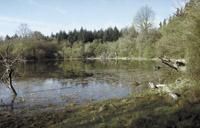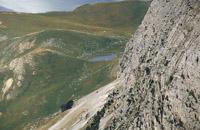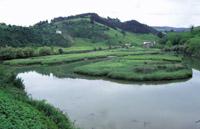Karst wetlands in the Basque Country
2000/11/01 Estonba Mintxero, Mikel Iturria: Elhuyar aldizkaria
Although karst wetlands are generally relatively rare, in most of our mountain ranges there are limestone geological structures, so it is a well represented wetland in the Basque Country. Most of the karst wetlands we find in the Basque Country come from the waterproofing of the small dissolution lines. Others appear in the collapse lines, usually larger. The latter, normally supplied with groundwater, do not present significant variations in water level, so they host richer and more structured living communities. Finally, in the Basque Country we find karst wetlands created in tuning forks. The majority receive the flow of groundwater and, sometimes due to its great depth, cannot be considered wetlands and are considered lagoons.
In all cases, besides being very useful to understand the geological and hydrological systems associated with them, it can be said that the environments are of great landscape value. The landscape value of these types of wetlands, their uniqueness and their high ecological interest make it necessary to protect them rigorously, but unfortunately so far most of them have been left out of protection policies.
Fortunately, however, being the majority in areas of inclined topography and having a steep edge, the human being has not undergone great transformations. It should not be forgotten that due to the hydrological characteristics of these wetlands, the water extractions or drains of the buckets not only significantly affect the water table, but the pollution foci are immediately spread in these systems, being able to reach places far from those that have occurred.
In the Basque Country, the most significant examples of karst wetlands are those produced in ranges scattered throughout our geography. Of these, undoubtedly, the most important in the region of the Alava valleys is the Areo lagoon, located in the municipality of Lantarón. It has an area of sixteen hectares and a depth of up to twenty-five meters. Due to its great depth, it is one of the few royal lakes that we find in Euskal Herria. However, with the exception of the north shore, the depth decreases little by little, so on the shores of this lake we find a magnificent wetland with very well structured rings of vegetation. It is an area of great ecological and natural value, with a singularity and unique landscape value. Therefore, the Basque Government and the Provincial Council of Alava have achieved their declaration of Biotope and its inclusion in the list of the International Ramsar Convention on Wetlands of Importance. We hope that these denominations serve to perpetuate this unique corner of Euskal Herria. Other wetlands associated with fingerboards are: The lagoon of Olandina, located in the valley of Maeztu de Álava, about twenty lagoons and small ponds located in the port of Altube in Álava, the lagoon of Arbieto in the depression of Urdu in Bizkaia or the lagoons of Iza and Loza located in Navarra, near Iru.
From the ecological and dimensional point of view, although the most important karst wetlands in the Basque Country are those originated in diapiros, the most abundant are those originated in the sierras and limestone regions. They are usually smaller and more abrupt, so they are less valuable from an ecological point of view. However, they constitute an important diversifying element of the landscape and, in addition, due to the hydrogeological characteristics that we have mentioned at the beginning, the limestone areas are very dry, so these small water deposits are of vital importance to the inhabitants of the place. Do not forget that the limestone saws suffer a strong livestock pressure, especially in summer. In fact, small water tanks have long been used by humans and, in many cases, have been transformed to accumulate more water.
As for its size, the lagoons of Arraga (Mouriscot) and Brindos and the lagoon of Marion, located in Lapurdi, between Biarritz and Anglet, are exceptional, especially the first two, with a surface of water exceeding thirty hectares and a depth exceeding ten meters. From an ecological point of view, however, the most interesting thing is Lake Marion, with little depth and soft slopes on its margins, since this type of wetlands are well structured by the plant and animal community itself.
In quantitative terms, the region with more lakes, lagoons or charcas of karst origin is the Sierra de Entzia-Urbasa-Andia. Basandia, Agilarrondo, Olaberri, Andasarri, Sarasa, Lator, Ikomar, Erna, Lordia, Uderbe, Zi–etarri, Idosia, etc. are the names of several wetlands that we can find along this long limestone. In addition, along the geography of the Basque Country we find numerous examples of karst wetlands such as the lagoons of Marikutz, Larraskanda or Bisusbide in the massif of Izarraitz (Gipuzkoa), the lagoon of the same name on Mount Santa Barbara de Hernani, the well of Unaga in the Sierra de Aralar, the lagoons of Gauzana.

Gai honi buruzko eduki gehiago
Elhuyarrek garatutako teknologia





